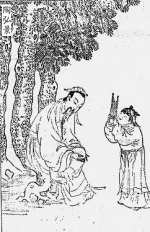 W
WThe military history of the Northern and Southern dynasties encompasses the period of Chinese military activity from 420 to 589. Officially starting with Liu Yu's usurpation of the Jin throne and creation of his Liu Song dynasty in 420, it ended in 589 with the Sui dynasty's conquest of Chen dynasty and reunification of China. The first of the Northern dynasties did not however begin in 420, but in 386 with the creation of Northern Wei. Thus there is some unofficial overlap with the era of the Sixteen Kingdoms.
 W
WThe Northern and Southern dynasties was a period in the history of China that lasted from 420 to 589, following the tumultuous era of the Sixteen Kingdoms and the Wu Hu states. It is sometimes considered as the latter part of a longer period known as the Six Dynasties. Though an age of civil war and political chaos, it was also a time of flourishing arts and culture, advancement in technology, and the spread of Mahayana Buddhism and Daoism. The period saw large-scale migration of Han Chinese to the lands south of the Yangtze. The period came to an end with the unification of all of China proper by Emperor Wen of the Sui dynasty.
 W
WSogdia or Sogdiana was an ancient Iranian civilization that at different times included territory located in present-day Uzbekistan, Tajikistan, Kazakhstan, and Kyrgyzstan, such as Samarkand, Bukhara, Khujand, Panjikent, and Shahrisabz. Sogdiana was also a province of the Achaemenid Empire, eighteenth in the list on the Behistun Inscription of Darius the Great. In the Avesta, Sogdiana is listed as the second best land that the supreme deity Ahura Mazda had created. It comes second, after Airyanem Vaejah, "homeland of the Aryans", in the Zoroastrian book of Vendidad, indicating the importance of this region from ancient times. Sogdiana was first conquered by Cyrus the Great, the founder of the Achaemenid Empire. The region would then be annexed by the Macedonian ruler Alexander the Great in 328 BC. The region would continue to change hands under the Seleucid Empire, Greco-Bactrian Kingdom, Kushan Empire, Hephthalite Empire, and Sasanian Empire.
 W
WTao Hongjing (456–536), courtesy name Tongming, was a Chinese polymath writer, calligrapher, waidan alchemist, pharmacologist, musician, and astronomer during the Northern and Southern dynasties (420–589). He is best known as a founder of the Shangqing "Highest Clarity" school of Daoism and the compiler-editor of the basic Shangqing religious texts.
 W
WLiu Yu's expeditions were a series of successful campaigns mounted by the Jin dynasty from 409 AD to 416 AD against Southern Yan, Later Qin, Northern Wei and Xia that successfully recovered all of Jin's territory south of the Yellow River with the exception of the Chang'an area, which was taken by Xia. These victories were the basis of the prosperity of the Reign of Yuanjia.
 W
WThe Śataśāstra is the reconstructed Sanskrit title of a Buddhist treatise in the Mādhyamaka tradition known only in its Chinese translation under the title Bai lun. Both names translate to the Hundred Verse Treatise, although the word "verse" is implied and not actually present in either Sanskrit or Chinese. It is attributed to Āryadeva, a student of Nāgārjuna. The text was translated into Chinese by Kumārajīva in 404 CE and came to be counted as one of the three foundational texts of the Three Treatise School. In the Chinese tradition, another text by Āryadeva called the Catuḥśataka—which was not translated into Chinese for another two and a half centuries, but is extant today in Sanskrit and Tibetan—was understood to be an expanded version of the Bai lun. However, scholars today have instead interpreted the Bai lun to be a summary the Catuḥśataka. Nonetheless, the sequence in which the topics are discussed differs, as do the specifics, and also the Bai lun has some content not seen in the Catuḥśataka at all. This has led to an alternative hypothesis that it may simply represent Kumārajīva's understanding of the Catuḥśataka.
 W
WThe Sixteen Kingdoms, less commonly the Sixteen States, was a chaotic period in Chinese history from 304 to 439 CE when the political order of northern China fractured into a series of short-lived dynastic states, most of which were founded by the "Five Barbarians," non-Chinese peoples who had settled in northern and western China during the preceding centuries and participated in the overthrow of the Western Jin dynasty in the early 4th century. The kingdoms founded by ethnic Xiongnu, Xianbei, Di, Jie, Qiang, as well as Chinese and other ethnicities, took on Chinese dynastic names, and fought against each other and the Eastern Jin dynasty, which succeeded the Western Jin and ruled southern China. The period ended with the unification of northern China in the early 5th century by the Northern Wei, a dynasty established by the Xianbei Tuoba clan, and the history of ancient China entered the Northern and Southern dynasties period.